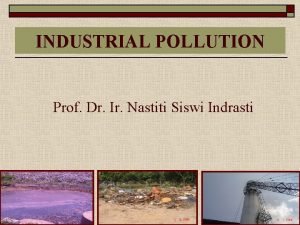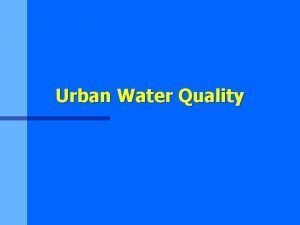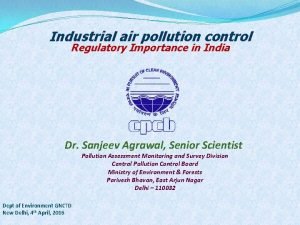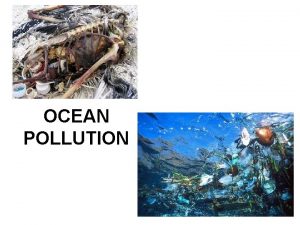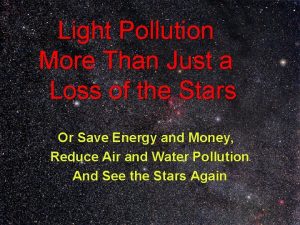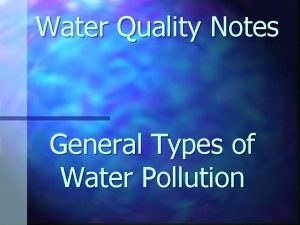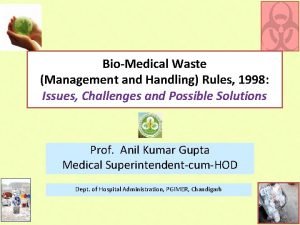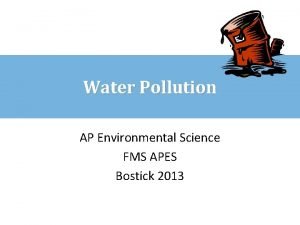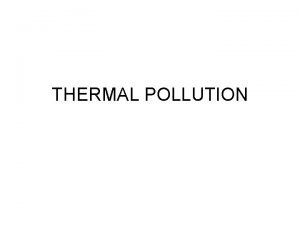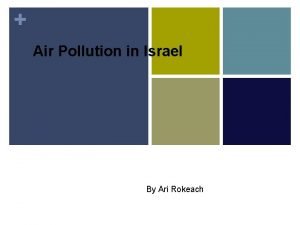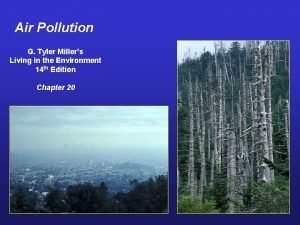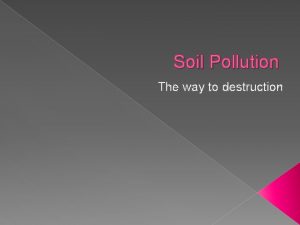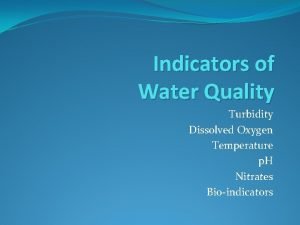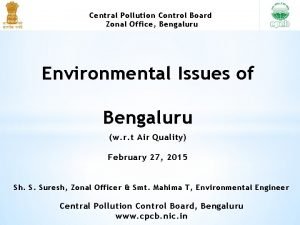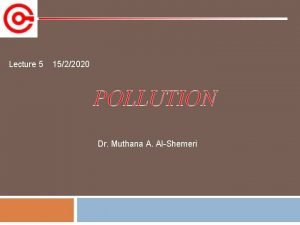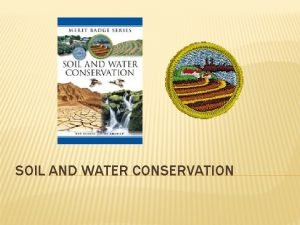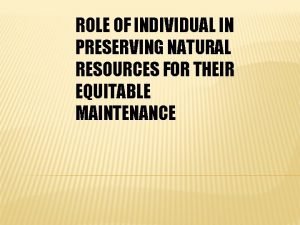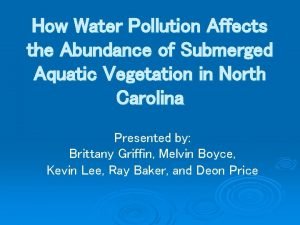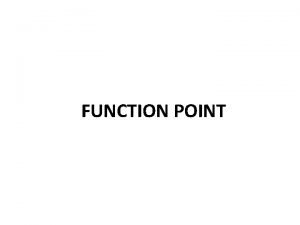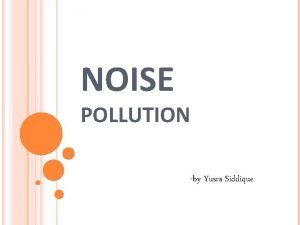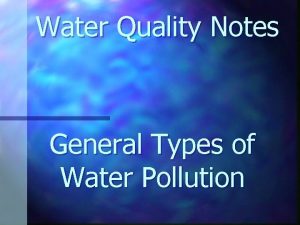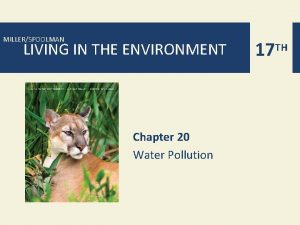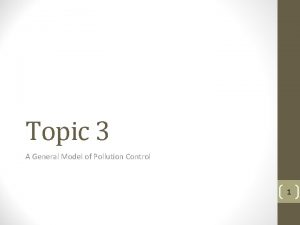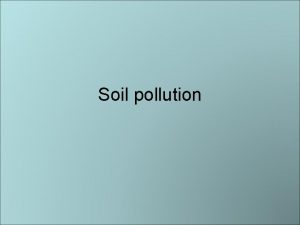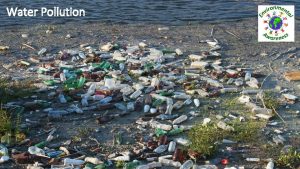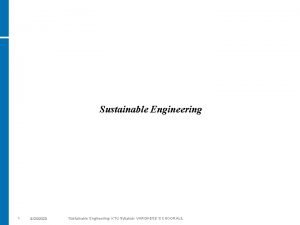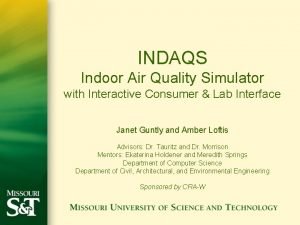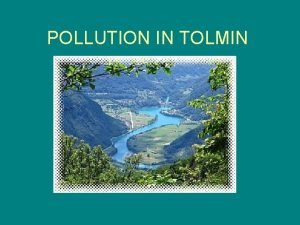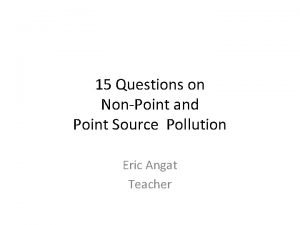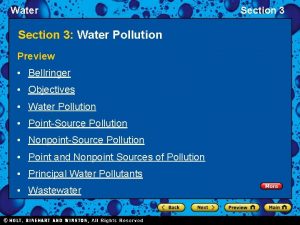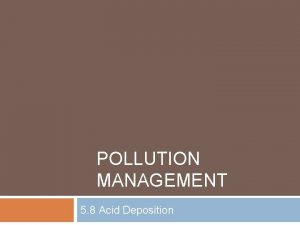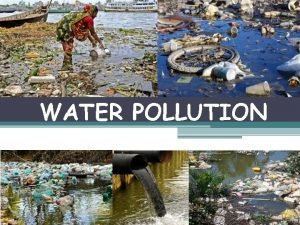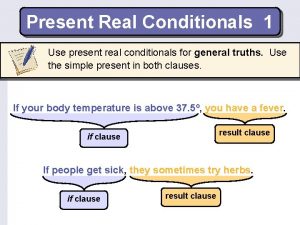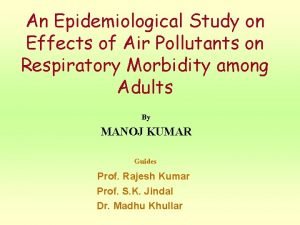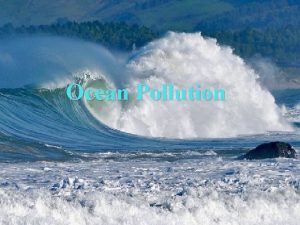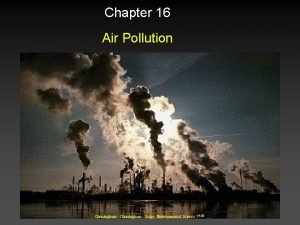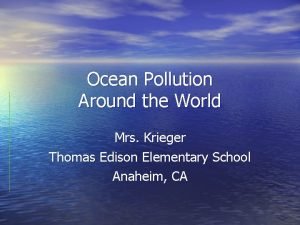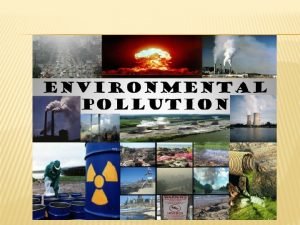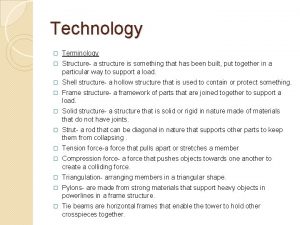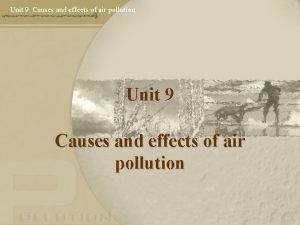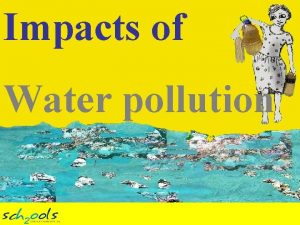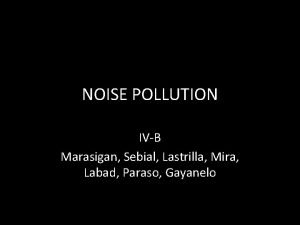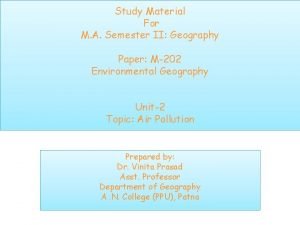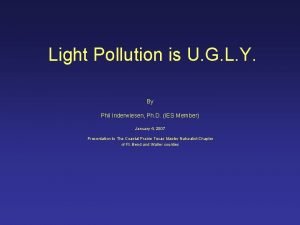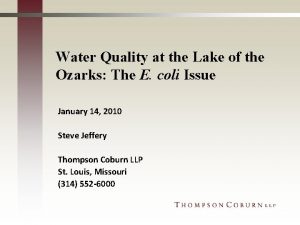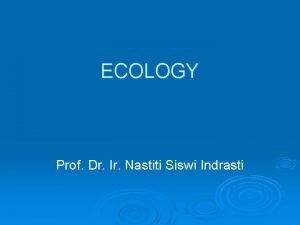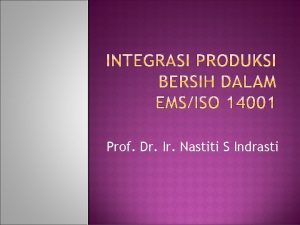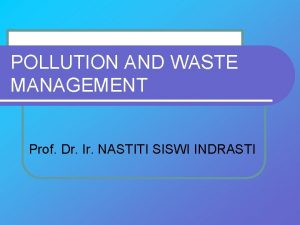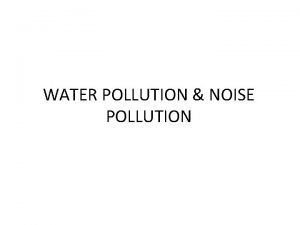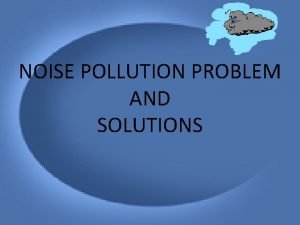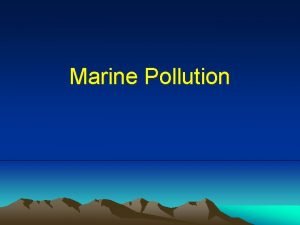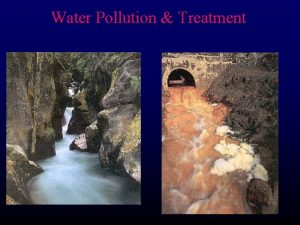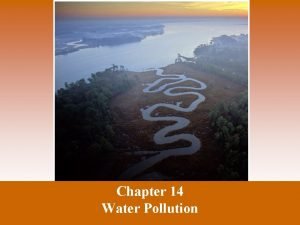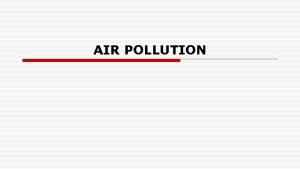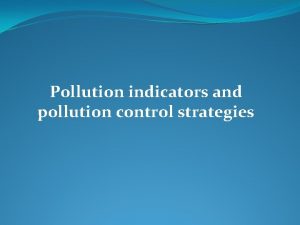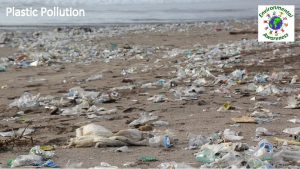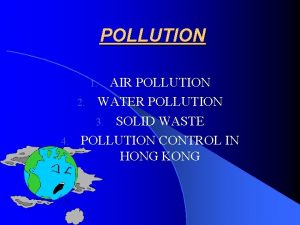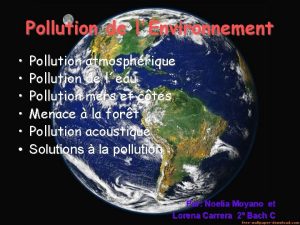INDUSTRIAL POLLUTION Prof Dr Ir Nastiti Siswi Indrasti




























































- Slides: 60

INDUSTRIAL POLLUTION Prof. Dr. Ir. Nastiti Siswi Indrasti

Water Pollution Prof. Dr. Ir. Nastiti Siswi Indrasti

Introduction o Water pollution is an imprecise tern that reveals nothing about either the type of polluting material or its source o Municipal wastewater, also called sewage, is a complex mixture containing water (usually over 99%) together with organic and inorganic contaminants, both suspended and dissolved

Principles of Wastewater Treatment

Treatment processes o Physical treatment gravity settling is the most common physical processes for removing suspended solids from wastewater o Biological treatment most of the organic constituents in wastewater can serve as food (substrate) to provide energy for microbial growth o Chemical processes for municipal wastewater, precipitation and disinfection are the only processes having wide application

PRIMARY TREATMENT FACILITY o Screening Bar screens o Mechanical cutting/shredding o Grid removal Grit chambers o Primary settling Sedimentation Comminutor

BAR SCREENS o Bar screens retain floating debris such as wood, rags or other bulky objects that could clog pipes or damage mechanical equipment in the rest of plant Figure 1. Typical bar screen installations

COMMINUTOR o Usually installed after coarse screens o Shreds and chops solid or rags that pass through the bar screen Figure 2. Typical comminutor installation

Figure 3. A mechanically cleaned grit chamber o Remove grit by collected them and reduction in velocity.

SECONDARY (BIOLOGICAL) TREATMENT FACILITY o o Trickling filters Activated sludge treatment Modification of the activated sludge process Other secondary treatment processes

Trickling filters Figure 4. Cutaway view of a trickling filter The trickling filter is a type of fixed-growth system: the microbes remain fixed or attached to a surface while the wastewater flows over that surface to provide contact with the organics.

Activated Sludge Treatment Air blower Compressed air Sewage influent Secondary effluent Primary settling Primary effluent Activated sludge Aeration tank Mixed liquor Secondary settling Return sludge Pump Figure 5. Typical activated sludge sewage treatment plant Excess sludge

Modifications Of The Activated Sludge Process Figure 6. A typical extended aeration package plant installation

Modifications Of The Activated Sludge Process air Activated sludge Aeration tank Secondary effluent Secondary clarifier Primary effluent Return sludge Pump waste sludge Figure 7. Flow diagram for the step aeration modification o the activated sludge

Other secondary treatment processes Figure 8. Circular prefabricated steel sewage treatment plants

Other Secondary Treatment Processes Figure 9. A series of rotating biological contractors, or biodiscs, for secondary wastewater treatment

TERTIARY (ADVANCED) TREATMENT FACILITY o o Effluent polishing Phosphorus removal Nitrogen removal Land treatment of wastewater

Effluent polishing o o Remove BOD and TSS from secondary effluents Using a mixed-media filter. The schematic diagram of an automatic-backwash tertiary filter is shown in figure

Figure 10. Auto backwash rapid filters may be used to polish the effluent in a tertiary or advanced sewage treatment plant. Diagram (a) shows the filtration mode, and diagram (b) shows the backwash mode of operation (c) three individual filter cells may be constructed in a single prefabricated

Phosphorus Removal o Involves chemical precipitation of the phosphate ions and coagulation. The organic phosphorus compounds are entrapped in the coagulant flocks that are formed and settle out in a clarifier. o One chemical frequently used in this process is aluminum sulfate (alum), Al 2 SO 4, the same coagulant chemical used to purify drinking water. o Other coagulant chemicals that may be used to precipitate the phosphorus include ferric chloride (Fe. Cl 3) and lime, Ca. O

Phosphorus removal Figure 9. Perspective view showing the basic components of micro-strainer unit

Nitrogen Removal Figure 10. Schematic Diagram of Nitrogen Removal

Land treatment of wastewater o o o Slow-rate infiltration systems spray irrigation, the most popular land application process, involves the intermittent application of secondary effluent (usually) on crops, vegetation, or forest land Rapid infiltration systems these systems require highly permeable soils to which wastewater is applied at high loading rates, to shallow, unvegetated basins Overland flow in this systems, pretreated wastewater is applied to fairly impervious land having a slope o 2 to 8% so that substantial runoff (as laminar flow) is produced and then collected

On-Site Treatment Facilities o Waterless Systems where no pressurized water is available or soil conditions are unsuitable or effluent disposal, the choice for on-site treatment are limited to privies or waterless toilets o Septic Tank the most common method of on-site wastewater treatment and disposal, can be designed for a small family or a large institution o Package Plants where treatment by septic tank would be inadequate, anaerobic package plants can produce an effluent with a BOD and SS concentration 30 to 50% of that from a septic tank

SLUDGE FACILITY o o Sludge treatment Sludge disposal

Sludge treatment Thickening Sewage sludge Dewatering Co-composting Digestion Dewatering Incineration Compost Ash Landfill Land application Sludge disposal options Figure 11. Alternative Pathways or Sewage Sludge Treatment and Disposal.

Figure 11. Schematic diagram of the two-stage anaerobic sludge digestion process Digestion reduces the total mass or weight of sludge solids, destroys pathogens and makes it easier to dry or dewater the sludge

DEWATERING Sludge dewatering is a process of removing enough water from a liquid sludge in order to change its consistency to that of moist earth Figure 11. A section of a sludge drying bed

SLUDGE DISPOSAL o o o Ocean dumping Land filling Incineration Land application Sale as fertilizer

INTRODUCTION o Definition The present of certain substances in the air in high enough concentrations and for long enough durations to cause undesirable effects

Global & Regional Pollution o pollutants : acid deposition ; C 02 ; CFC ; atomic reaction pollutants in nature or industry; heavy metal ; organochlorine from pesticide ; mountain activities; forest fire. o The example of regional pollutants : acid deposition o The component of acid deposition : SO 2 and NO from the oxidation and hydrolysis H 2 SO 4 , HNO 3 and CO 2 o CO 2 is the main component of greenhouse effect and global warming beside the CFC and methane. o The effect in atmosphere causing the diminished ozone

The main pollutants in atmosphere o o o In the beginning, the air pollutants is detected by sensory perception without equipment SO 2 causing silver layer into black, damaged plants and in extreme situation causing hard breathing Ozone causing rubber and synthetic material disturbed , in high concentration stimulate tear

The Influence Of Air Pollution The Influences For Human Health Base on US EPA 450 -R-92 -001 (1992), in the open air, there are : ü solid particle and liquid particle ü Sulfur oxide ü carbon monoxide ü Nitrogen dioxide ü Pb

The Influences for Plants and Human In A biotic environment ü Sulfur ü Nitrogen ü Fluorine ü Hydrogen sulfide with Pb oxide

Gas Emission Control There are 3 general ways to reduce the gas emission : 1. 2. 3. Decrease or omitted the unnecessary production Produce the good gas emission for the environment Transfer the unnecessary gas emission by absorption, there are transferring the gas into water or deposition of gas molecule into solid surface

SOLID WASTE Prof. Dr. Ir. NASTITI SISWI INDRASTI

SOLID WASTE MANAGEMENT ACTIVITIES INFRASTRUCTURE Planning Design Financing Construction Operation Collection Transport Processing Recycling Disposal

Solid waste characteristic o Type of solid waste n n Municipal solid waste (MSW): non-hazardous solid waste from a city, town, village that requires routine or a periodic collection and transport to a processing or disposal site NON Municipal Solid Waste: include industrial process waste, construction and demolition debris, sewage sludge, mining waste or agricultural waste.

Municipal solid waste Refuse Garbage Trash Rubbish Routine collection a periodic collection Waste processing Energy recovery Recycling Final disposal Figure 1. General classification of municipal solid wastes (MSW)

Solid waste collection Collection includes temporary storage or containerization, transfer to a collection vehicle and transport to a site where the waste undergoes processing and ultimate disposal. Waste collection is the most expensive phase, largely because it is labor intensive.

Mechanical collection systems Automatic systems o o Semiautomatic systems In fully automatic systems, an articulated arm mechanism on the vehicle engages, lifts, empties and replaces the container without manual assistance. Semiautomatic systems require a truck crew member to place the container in position to be automatically hoisted and emptied into the collection truck and then manually returned to its setout position

Solid waste collection o Transfer station is a facility at which solid wastes from individual collection trucks are consolidates into larger vehicles, such as tractor-trailer units. There are two basic modes of operation: direct discharge or storage discharge. o In storage discharge transfer station, the refuse is first emptied from the collection trucks into a storage pit or onto a large platform. o In a direct discharge station, each refuse truck empties directly into the larger transport vehicles.

Solid waste processing o o Reduce the total volume and weight Changes its form and improve its handling characteristic To recover natural resources and energy in the waste material for reuse or recycling The most widely used municipal waste treatment processes including incineration, shredding, pulverizing, baling and composting.

Incineration o o Incineration is a thermal oxidation with the furnace temperatures are about 815 -1400 0 C. Incineration result: n POC (product of complete combustion): CO 2, H 2 O n PIC( product of incomplete combustion): CO 2, hydrocarbon, amine, organic acid, polycyclic organic matter, etc. The incineration result composition is influenced with the waste characteristic Incineration requirements: excessive oxygen to minimize the PIC

Operation of incinerator Must be consistent Needs: • Good understanding of waste characteristics • Technical skills • Control of waste feed • Mixing of wastes • Temperature to be kept at required level despite variations in waste • Excess air • Flue gas control • Regular maintenance Source: David C Wilson

Energy recovery Waste combustion produces heat but combustion of low CV wastes may not be self-supporting Energy recovery is via production of steam to generate electricity • Only steam production: 80% efficiency is typical • Steam can be used for in-house demands • Steam can be delivered to adjacent users eg other industrial plants • Electricity can be generated: 25% efficiency typical Opportunities to sell heat are improved where facilities are in industrial areas Sale of surplus energy improves plant economics

Figure 4. Schematic of rotary kiln waste-to-energy furnace Source: Indaver

Pyrolysis = thermal decomposition process which takes place in the total absence of oxygen Products of pyrolysis: • combustible gases • mixed liquid residue Advantages: • low operating temperature • no need for excess air so less flue gas • by-products are combustible

Gasification = incomplete combustion in the partial absence of oxygen Enables efficient destruction of hazardous waste at lower temperatures than incineration Thermal destruction is ensured by a combination of high-temperature oxidation followed by high temperature reduction

Shredding and Pulverizing Size reduction of municipal solid waste such as cutting and tearing, where as pulverizing refers to the actions of crushing and grinding

Hammer mills: types of equipment used for processing MSW into uniform or homogeneous mass Figure 5. Vertical Hammer Mill

High-pressure compaction units Baling: compacting solid waste into the form of rectangular blocks or bales.

Composting o Composting is a process in which the organic portion of MSW is allowed to decompose under carefully controlled conditions by the action of bacteria, fungi and other microorganism o With proper control of moisture, temperature and aeration, a composting plant can reduce the volume of the raw organic material by as much as 50 percent. o A complete municipal solid waste composting operation includes sorting and separating, shredding and pulverizing, digestion product upgrading and marketing.

o The composting waste is aerated by periodically turning each windrow. This can be done manually with a pitchfork, but at most large facilities it is machinery. Some of these machines turn and rebuild the windrow directly behind the machine; others rebuild the turned windrow adjacent to its original position figure 6

Figure 6. (a) windrow turning machine (b) windrow turning arrangement

Co-composting o An interesting example of integrated waste management is a co-composting of municipal solid waste and sewage sludge. o Sewage sludge adds nitrogen, phosphorus and other elements that enrich the solid waste and helps the composting process

Figure 7. Enclosed mechanical-type composting system (reprinted with permission from composting and recycling, Louis F. Diaz, 1993)

Figure 8. Schematic of aerated static pile composting system. (Tchobanglous, G. , et. al. )

Recycling What is recycling? • The re-use and remanufacture of waste materials What is the purpose of recycling? • To recover useful materials and save resources • To prevent pollutants reaching the waste stream What are the benefits of recycling? • More efficient resource use, lower energy consumption, reduced pollution

 Siswi
Siswi Water pollution
Water pollution Air pollution means
Air pollution means Pacific garbage patch
Pacific garbage patch Advantages of pollution
Advantages of pollution Light pollution facts
Light pollution facts Introduction for water pollution
Introduction for water pollution Type of reefs
Type of reefs Chapter 12 air section 1 what causes air pollution
Chapter 12 air section 1 what causes air pollution Cwtf in bio-medical waste
Cwtf in bio-medical waste Primary treatment definition apes
Primary treatment definition apes Thermal pollution control
Thermal pollution control Air pollution 2050
Air pollution 2050 Pollution causes effects and solutions
Pollution causes effects and solutions Ari rokeach
Ari rokeach Air pollution
Air pollution Baghouse filter definition apes
Baghouse filter definition apes Indoor air pollution examples
Indoor air pollution examples Concept of soil pollution
Concept of soil pollution Chapter 11 section 1 water resources
Chapter 11 section 1 water resources Dissolved oxygen in water
Dissolved oxygen in water Central and state pollution control board
Central and state pollution control board Two sources of air pollution
Two sources of air pollution Cause of noise pollution
Cause of noise pollution Soil conservation project
Soil conservation project Conclusion of soil pollution
Conclusion of soil pollution Summary of water pollution
Summary of water pollution Pollution board game
Pollution board game Function point
Function point Effects of noise pollution on human health
Effects of noise pollution on human health Middle east
Middle east What is visual pollution definition
What is visual pollution definition High level of pollution
High level of pollution Methods to control water pollution
Methods to control water pollution Three level model of pollution management
Three level model of pollution management Soil pollution project
Soil pollution project Conclusion of water pollution
Conclusion of water pollution Ktu sustainable engineering notes
Ktu sustainable engineering notes Air pollution simulator
Air pollution simulator Soca pollution
Soca pollution Major source of water
Major source of water Section 3 water pollution
Section 3 water pollution Pollution management strategies for acid deposition
Pollution management strategies for acid deposition Water pollution introduction
Water pollution introduction Water pollution theory
Water pollution theory Real present
Real present Air pollution
Air pollution Aims of air pollution
Aims of air pollution Sources of thermal pollution
Sources of thermal pollution Adjectives for air pollution
Adjectives for air pollution Ocean pollution
Ocean pollution Primary vs secondary pollution
Primary vs secondary pollution Ocean pollution
Ocean pollution What is inorganic pollution
What is inorganic pollution What is a structure in technology
What is a structure in technology Air pollution
Air pollution Effects of water pollution
Effects of water pollution Control of noise pollution ppt
Control of noise pollution ppt Meaning of environmental pollution
Meaning of environmental pollution Light eyes map
Light eyes map Lake of the ozarks water quality
Lake of the ozarks water quality
